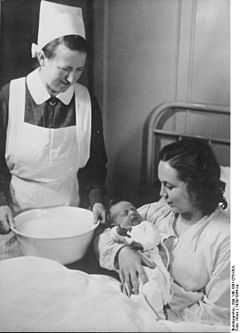Nurse's cap

A nurse's cap or nursing cap is part of the female nurse's uniform, introduced early in the history of the profession. The cap's original purpose was to keep the nurse's hair neatly in place and present a modest appearance. Male nurses do not wear caps.
In some schools, a capping ceremony presents new nursing students their caps before beginning their clinical (hospital) training.
History

The nurse's cap originated from a group of women in the early Christian era, called "deaconesses." Deaconesses are now recognized as religious order nuns. These women were distinguished from other women during this time by white coverings worn on their heads. This particular head covering was worn to show that this group of women worked in the service of caring for the sick. Originally, this head covering was more of a veil, but it later evolved into a white cap during the Victorian era. It was during this era that proper women were required to keep their heads covered. The cap worn was hood-shaped with a ruffle around the face and tied under the chin, similar to cleaning ladies of that day. Long hair was fashionable during the Victorian era, so the cap kept the nurse's hair up and out of her face, as well as keeping it from becoming soiled.[1]
The nurse's cap was derived from the nun's habit and developed over time into two types:
- A long cap, that covers much of the nurse's hair, and
- A short cap, that sits atop the nurse's hair (common in North America and the United Kingdom).
The nursing cap was originally used by Florence Nightingale in the 1800s.
Different styles of caps were used to depict the seniority of the nurse, the frillier and longer the more senior the nurse.
Advantages

The nursing cap is a nearly universally recognized symbol of nursing. It allows patients to quickly identify a nurse in the hospital from other members of the health team.
Disadvantages
Some claim the cap is a potential carrier of bacteria and other disease-causing pathogens that could then be transmitted from patient to patient.[2] However, such incidents can be prevented when infection control procedures are followed.
Standardized Caps per School
Around 1874, the Bellevue Hospital School of Nursing in New York City adopted a special nursing cap as a way to identify nurses who had graduated from Bellevue. The Bellevue cap covered the entire head except the ears, and can be compared to a current ski hat, although it was made out of white linen and had fringe around the bottom. As the number of nursing schools increased, so did the need for unique caps. Each nursing school decided to design their own style of nurse’s cap. Some became very elaborate and some were even different shapes. Because each school had their own cap, it became very easy to determine which school the nurse had graduated from.[1]
Nurses' caps since the 1980s
The use of nurses' caps in the medical facilities of the United States (as well as many other nations) all but disappeared by the late 1980s with the near universal adoption of "scrubs." Healthcare facilities no longer required for their nurses to wear nurse’s caps, which led to nursing schools eliminating the cap as a mandatory part of the students’ uniform. In addition, with the growth of technology in the health-care setting, nurse’s caps became an obstacle for nurses wearing them.[1] Also, the rapid growth of the number of men in nursing also necessitated a unisex uniform. However, nurses' caps can still be found in many developing nations, as well as some countries where women still make up the overwhelming majority of nurses. It is also common for students of nursing to have their graduation portraits taken while wearing nurses' caps.
Although the nursing cap is no longer required as a part of a nurse’s uniform, it still holds the same significance that it did during the time of Florence Nightingale. The nursing cap symbolizes the goal of nurse, which is to provide “service to those in need.” Furthermore, the cap is a sign of the industry’s ageless values of dedication, honesty, wisdom, and faith.[1]
See also
References
- ↑ 1.0 1.1 1.2 1.3 Catalano, Joseph T. (2012). Nursing Now!: Today's Issues, Tomorrow's Trends (6th ed.). Philadelphia, PA: F.A. Davis. pp. 29–30.
- ↑ Houweling, Lynn (2004). "Image, function, and style: A history of the nursing uniform.". AJN: American Journal of Nursing 104 (4): 40–8. PMID 15171114.
External links
- Civilization.ca - Symbol of a Profession: One Hundred Years Of Nurses' Caps
- What Happened to the Cap? (a three part slide show on Medscape): Part 1: Dignity and Dedication, Part 2: Losing Our Tradition, Part 3: A Profession Moves On(registration required)